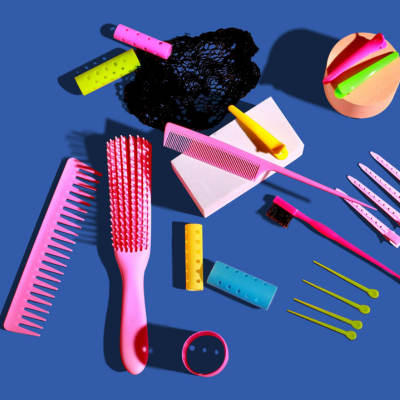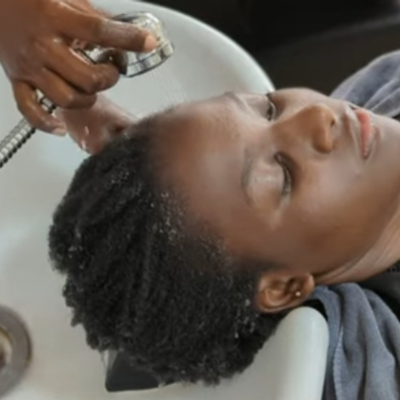- Support 24/7
- +1 (480) 468-4543
- livara@mylivara.com
How To Maintain Natural Hair: Weekly, Monthly, and Seasonal Routines for 4C Hair

What’s The Right Way To Use Detangling Tools? How To Use Brushes, Combs, and Fingers
June 7, 2024
Slip: Why It’s the Secret Weapon for Healthy, Happy Curls
June 13, 2024
If you have 4C hair, you know it can be both a beautiful crown and a bit of a puzzle. With its tight coils and unique texture, 4C hair needs extra love and care to keep it healthy and thriving. Whether you’re a seasoned naturalista or just starting your natural hair journey, understanding how to maintain your 4C hair on a weekly, monthly, and seasonal basis is crucial. In this comprehensive guide, we’ll break down the routines and tips that will help you embrace your natural hair with confidence and ease.
Weekly Routine
One of the golden rules for 4C hair is keeping it moisturized. Due to its coily structure, 4C hair tends to be drier because the natural oils from the scalp struggle to travel down the hair shaft. Here’s a step-by-step guide to ensure your hair stays hydrated:
Moisturize and Seal
- Daily Spritz: Use a water-based moisturizer or simply a spray bottle filled with water to mist your hair daily. This helps to refresh your curls and provide a moisture base.
- Creams and Butters: After spritzing, apply a moisturizing cream or butter. Look for products with ingredients like shea butter, mango butter, and aloe vera.
- Seal with Oil: Seal in the moisture with natural oils such as coconut oil, olive oil, or jojoba oil. This step helps to lock in the hydration and adds shine to your curls.
Gentle Cleansing
Washing 4C hair too frequently can strip it of its natural oils, leading to dryness. Aim to cleanse your hair once every 1-3 weeks using a sulfate-free shampoo:
- Sulfate-Free Shampoo: Choose a gentle shampoo like the Sapphire Hair Shampoo that cleanses without stripping moisture. Focus on your scalp, where most of the buildup occurs.
Deep Conditioning
Deep conditioning is a must for 4C hair to ensure it remains soft, manageable, and strong. Incorporate a deep conditioning treatment like our 2in1 Sapphire Deep Conditioner and Leave-In Treatment into your weekly routine:
- Apply Generously: After washing your hair, apply a generous amount of deep conditioner, focusing on the ends.
- Heat for Penetration: For better absorption, cover your hair with a plastic cap or sit under a hooded dryer for 20-30 minutes. The heat helps the conditioner penetrate the hair shaft deeply.
- Rinse Thoroughly: After the treatment, rinse your hair thoroughly with cool water to seal the cuticles.
Protective Styling
Protective styles help to minimize manipulation and reduce the risk of breakage. Some popular weekly protective styles for 4C hair include:
- Twists or Braids: These can be worn under wigs or hats or as a style on their own.
- Buns and Updos: These styles keep the ends tucked away and protected.
- Headwraps and Scarves: Not only do they protect your hair, but they also add a stylish element to your look.
Monthly Routine
Clarifying Treatment
Once a month, it’s essential to give your hair a thorough cleanse to remove product buildup and restore its natural bounce. This can be great for your hair and scalp after taking out a protective style you’ve had in for a couple of weeks.
- Clarifying Shampoo: Use a clarifying shampoo to remove any residue from hair products. Follow up with a deep conditioning treatment to replenish moisture.
Protein Treatment
Protein treatments are essential for strengthening hair that has been weakened or damaged. However, if you have 4C hair that is weak, damaged, or has undergone chemical treatments like dyeing, relaxing, or excessive heat styling, you should specifically use these treatments. Here’s when and how to use a protein treatment
- If your hair feels mushy when wet, is extremely stretched out, or breaks easily, it might indicate that it needs a protein treatment. Signs of damage from chemical treatments, frequent heat use can also indicate the need for protein.
- Protein-Rich Products: Use a protein treatment with hydrolyzed proteins. Be cautious not to overuse protein treatments as they can lead to dryness if done too frequently. There are also several DIY protein treatments you can do at home using natural ingredients. Here are a few popular options:
1. Egg and Olive Oil Treatment
Eggs are rich in protein and can help strengthen and condition your hair.
- Ingredients:
- 1-2 eggs (depending on hair length and thickness)
- 2 tablespoons of olive oil
- Instructions:
- Beat the eggs in a bowl.
- Add olive oil and mix well.
- Apply the mixture to your hair, focusing on the ends.
- Cover your hair with a shower cap and leave it on for 20-30 minutes.
- Rinse thoroughly with cool water (to avoid cooking the eggs in your hair), then shampoo and condition as usual.
2. Avocado and Yogurt Treatment
Avocados are packed with vitamins and fatty acids, while yogurt contains proteins and lactic acid that can help strengthen and moisturize hair.
- Ingredients:
- 1 ripe avocado
- 1/2 cup plain yogurt
- Instructions:
- Mash the avocado until smooth.
- Mix in the yogurt to form a creamy paste.
- Apply the mixture to your hair from root to tip.
- Cover with a shower cap and leave it on for 30-45 minutes.
- Rinse thoroughly with cool water, then shampoo and condition.
3. Mayonnaise and Honey Treatment
Mayonnaise contains eggs and oils, making it a great protein treatment, while honey adds moisture and shine.
- Ingredients:
- 1/2 cup mayonnaise
- 2 tablespoons honey
- Instructions:
- Mix the mayonnaise and honey in a bowl.
- Apply the mixture to damp hair, focusing on damaged areas.
- Cover your hair with a shower cap and leave it on for 30 minutes.
- Rinse thoroughly with warm water, then shampoo and condition.
Frequency of protein treatments: For those with chemically treated or severely damaged hair, a protein treatment once a month can be beneficial. If your hair is in good condition and not chemically treated, you may only need to use it once in a while, every 8 weeks or so. Always follow up with a moisturizing deep conditioner like the 2in1 Sapphire Deep Conditioner and Leave-In Treatment to maintain balance.
Trim Your Ends
Trimming your ends when you notice split ends helps to maintain the health of your hair and prevent damage from split ends traveling up the hair shaft:
- DIY Trim: Use sharp scissors to carefully trim the ends of your hair. Make sure to trim uniform amounts of hair and to work in sections for an even look.
- Professional Trim: Alternatively, visit a professional stylist who is experienced with 4C hair to get a precise trim.
Seasonal Routine
Living in East Africa, you experience a mix of wet and dry seasons that can affect your 4C hair differently. Here’s how to adapt your routine to each climate:
Dry Season
During the dry season, your hair is more prone to dryness and brittleness because of the lack of humidity and moisture in the air. Here’s how to keep your hair hydrated and healthy:
- Hydration is Key: Increase your water intake and use hydrating hair products like the Tsavorite Spritz Moisturizer Hair Spray to combat the drying effects of the arid air.
- Heavier Moisturizers: Use leave-in treatments and butters like the nourishing shea butter and avocado oil-infused Emerald Hair Food to lock in moisture.
- Protective Styles: Wear protective styles like braids, twists, and wigs to minimize exposure to the dry air and reduce the risk of breakage.
- Steam Treatments: Incorporate steam treatments to boost moisture retention. Using a steaming cap or steaming your hair in the shower can help to keep your hair hydrated.
Wet Season
The wet season brings higher humidity and more frequent rainfall, which can make your hair more prone to frizz and shrinkage. Here’s how to manage your 4C hair during this time:
- Anti-Humidity Products: Use anti-humidity hair products like natural hair oils that help to seal the cuticle and prevent frizz. Hair oils can help to protect your hair from humidity by creating a barrier that prevents excess moisture from the air from penetrating the hair shaft. Look out for natural oils like avocado, castor, argan, jojoba, and shea butter.
- Lighter Products: Opt for lighter products like moisturizing hair sprays to prevent your hair from feeling weighed down in the humid air. Products with glycerin and aloe vera like can help to maintain moisture balance.
- Protective Styles: Continue to use protective styles like twists, braids, and cornrows to reduce manipulation and protect your hair from excess moisture.
- Cover Up: On rainy days, use headwraps, scarves, or hats to protect your hair from getting wet. This can help to maintain your style and prevent your hair from becoming overly frizzy.
Additional Tips for Every Season
- Satin or Silk: Sleep on a satin or silk pillowcase or use a satin bonnet to reduce friction and retain moisture.
- Scalp Care: Keep your scalp healthy by massaging it regularly with natural oils to promote blood circulation and hair growth.
- Hydration and Nutrition: Drink plenty of water and maintain a balanced diet rich in vitamins and minerals to support healthy hair growth from the inside out.
Embrace the Journey
Taking care of 4C hair requires patience, consistency, and a bit of trial and error. What works for one person might not work for another, so it’s important to listen to your hair and adjust your routine as needed. Embrace the journey, celebrate the unique beauty of your curls, and remember that with the right care, your 4C hair can flourish and shine.
Maintaining 4C hair is more than just a routine—it’s an act of self-love and appreciation for your natural beauty. With these weekly, monthly, and seasonal tips, you’ll be well on your way to keeping your hair healthy, hydrated, and happy. So go ahead, give your hair the care it deserves, and enjoy the beautiful results! Because you are a gem.



